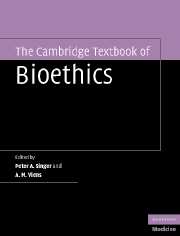Book contents
- Frontmatter
- Contents
- List of contributors
- Acknowledgements
- 1 Introduction
- Section I Information problems
- Section II End of life care
- Section III Pregnant women and children
- Section IV Genetics and biotechnology
- Section V Research ethics
- Section VI Health systems and institutions
- Section VII Using clinical ethics to make an impact in healthcare
- Section VIII Global health ethics
- Section IX Religious and cultural perspectives in bioethics
- Introduction
- 47 Aboriginal bioethics
- 48 Buddhist bioethics
- 49 Chinese bioethics
- 50 Hindu and Sikh bioethics
- 51 Islamic bioethics
- 52 Jehovah's Witness bioethics
- 53 Jewish bioethics
- 54 Protestant bioethics
- 55 Roman Catholic bioethics
- Section X Specialty bioethics
- Index
- References
47 - Aboriginal bioethics
Published online by Cambridge University Press: 30 October 2009
- Frontmatter
- Contents
- List of contributors
- Acknowledgements
- 1 Introduction
- Section I Information problems
- Section II End of life care
- Section III Pregnant women and children
- Section IV Genetics and biotechnology
- Section V Research ethics
- Section VI Health systems and institutions
- Section VII Using clinical ethics to make an impact in healthcare
- Section VIII Global health ethics
- Section IX Religious and cultural perspectives in bioethics
- Introduction
- 47 Aboriginal bioethics
- 48 Buddhist bioethics
- 49 Chinese bioethics
- 50 Hindu and Sikh bioethics
- 51 Islamic bioethics
- 52 Jehovah's Witness bioethics
- 53 Jewish bioethics
- 54 Protestant bioethics
- 55 Roman Catholic bioethics
- Section X Specialty bioethics
- Index
- References
Summary
Mr. A, a 70-year-old Aboriginal elder who speaks only Ojibway, is admitted to a tertiary care hospital for diagnostic investigation of possible prostate cancer. Initially, only a female interpreter is available, and she has difficulty translating the physician's references to the penis while obtaining consent for cystoscopy. When asked to tell Mr. A that the procedure would aid in cancer diagnosis, she refuses to translate the concept of cancer directly and, instead, uses the word for “growth.” The patient responds that he does not fully understand the diagnostic test but trusts the interpreter and the urologist and agrees to sign the consent form. During cystoscopy, both his son and a male interpreter, are present to translate. Following the biopsy and other diagnostic tests, Mr. A, his son, the male interpreter, and the urologist meet. Addressing the son and the interpreter, the urologist explains that Mr. A has advanced cancer spreading to bone. When asked by the son about treatment, the urologist replies that any attempted curative treatment would probably cause more risk and discomfort than would pain relief and other palliative measures. The interpreter begins to translate the urologist's summary, but his explanation of the diagnosis is interrupted by the son, who says that he will communicate directly with his father. He states that the interpreter should not have used the Ojibway word “manitoc,” which denotes cancer through the cultural metaphor of “being eaten from within,” and that direct reference to cancer and his father's terminal prognosis will promote fear and pain.[…]
- Type
- Chapter
- Information
- The Cambridge Textbook of Bioethics , pp. 383 - 390Publisher: Cambridge University PressPrint publication year: 2008



